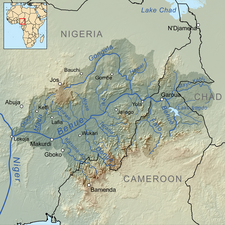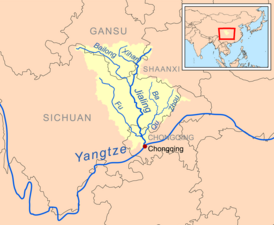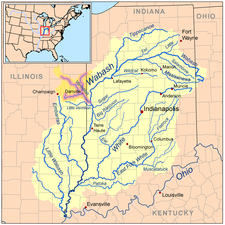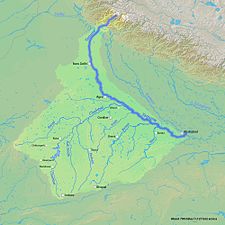Tributary

Atributary,[1]or anaffluent,[2]is astreamorriverthat flows into a larger stream (main stemor"parent"), river, or alake.[3]A tributary does not flow directly into aseaorocean.[4]Tributaries, and the main stem river into which they flow, drain the surroundingdrainage basinof its surface water andgroundwater,leading the water out into an ocean.
TheIrtyshis a chief tributary of theObriver and is also the longest tributary river in the world with a length of 4,248 km (2,640 mi). TheMadeira Riveris the largest tributary river by volume in the world with an average discharge of 31,200 m3/s (1.1 million cu ft/s).
Aconfluence,where two or morebodies of watermeet, usually refers to the joining of tributaries.
The opposite to a tributary is adistributary,a river or stream that branches off from and flows away from the main stream.[5]Distributaries are most often found inriver deltas.
Terminology
[edit]
Right tributary,orright-bank tributary,andleft tributary,orleft-bank tributary,describe the orientation of the tributary relative to the flow of the main stem river. These terms are defined from the perspective of looking downstream, that is, facing the direction thewater currentof the main stem is going. In anavigationalcontext, if one were floating on araftor other vessel in the main stream, this would be the side the tributary enters from as one floats past; alternately, if one were floating down the tributary, the main stream meets it on theoppositebank of the tributary. This information may be used to avoidturbulentwater by moving towards the opposite bank before approaching the confluence.[6]
Anearly tributaryis a tributary that joins the main stem river closer to its source than its mouth, that is,beforethe river'smidpoint;alate tributaryjoins the main stem further downstream, closer to its mouth than to its source, that is,afterthe midpoint.
In the United States, where tributaries sometimes have the same name as the river into which they feed, they are calledforks.These are typically designated by compass direction. For example, theAmerican Riverin California receives flow from its North, Middle, and South forks. TheChicago River's North Branch has the East, West, and Middle Fork; the South Branch has its South Fork, and used to have a West Fork as well (now filled in).
Forks are sometimes designated as right or left. Here, the handedness is from the point of view of an observer facing upstream. For instance,Steer Creekhas a left tributary which is called Right Fork Steer Creek.
These naming conventions are reflective of the circumstances of a particular river's identification and charting: people living along the banks of a river, with a name known to them, may then float down the river in exploration, and each tributary joining it as they pass by appears as a new river, to be given its own name, perhaps one already known to the people who live upon its banks. Conversely, explorers approaching a new land from the sea encounter its rivers at their mouths, where they name them on their charts, then, following a river upstream, encounter each tributary as a forking of the stream to the right and to the left, which then appear on their charts as such; or the streams are seen to diverge by thecardinal direction(north, south, east, or west) in which they proceed upstream, sometimes a third stream entering between two others is designated themiddlefork; or the streams are distinguished by the relative height of one to the other, as one stream descending over acataractinto another becomes theupperfork, and the one it descends into, thelower;or by relative volume: the smaller stream designated thelittlefork, the larger either retaining its name unmodified, or receives the designationbig.[7]
Ordering and enumeration
[edit]Tributaries are sometimes listed starting with those nearest to thesource of the riverand ending with those nearest to themouth of the river.TheStrahler stream orderexamines the arrangement of tributaries in ahierarchyof first, second, third and higher orders, with the first-order tributary being typically the least in size. For example, a second-order tributary would be the result of two or more first-order tributaries combining to form the second-order tributary.[6]
Another method is to list tributaries from mouth to source, in the form of atree structure,stored as atreedata structure.[citation needed]
Gallery
[edit]- A gallery of major river basins with tributaries
-
The basin of theAmazon Riveris a system made up of many tributary streams. The streams shown on the map besides the Amazon are tributaries of the Amazon.
-
TheBenue Riveris fed by multiple tributaries originating in theAdamawa Plateau;many of the highest tributaries are seasonal streams. The Benue is itself a major tributary of theNiger.
-
Huai River(itself a tributary of theYangtze) and tributaries
-
Jialing River(itself a tributary of theYangtze) and tributaries
-
TheLiao Riveris a much simpler example of a river basin with tributaries. The main tributaries noted on this map are theHun River,Taizi River,Dongliao River,Xinkai River,Xiliao River,Xar Moron Riverand theLaoha River.The Xiliao River's tributaries are the Xar Moron and Laoha rivers.
-
TheMekongis a trans-boundary river, originating in theTibetan Plateau.Its upper tributary river systems (e.g.ngom chu) are restricted to narrowgorges,but the tributaries that feed its lower reaches (e.g. theMun River) cover larger areas.
-
The water basin of theWabash River;the other rivers (not including theOhio River) are tributaries of the Wabash River. The Vermillion River (and itsforks) is a highlighted example of a tributary of the Wabash River. The Wabash River is also a tributary of the Ohio River, which in turn is a tributary of theMississippi River.
-
TheYamunais the second-largest tributary river of theGangesand the longest tributary inIndia.It flows almost parallel to the Ganges about its right bank for 1,376 kilometres (855 mi) before merging with it at theTriveni Sangam,Allahabad.
See also
[edit]References
[edit]- ^"tributary".PhysicalGeography.net, Michael Pidwirny & Scott Jones, 2009. Viewed 17 September 2012.
- ^"affluent".The American Heritage Dictionary of the English Language, Fourth Edition. Houghton Mifflin Company, 2004. Viewed 30 September 2008.
- ^"Definition of TRIBUTARY".Merriam-Webster.
- ^Krebs, Robert E. (2003).The Basics of Earth Science.Greenwood Publishing Group.ISBN978-0-313-31930-3.
- ^"opposite to a tributary".PhysicalGeography.net, Michael Pidwirny & Scott Jones, 2009. Viewed 17 September 2012.
- ^abBisson, Peter; Wondzell, Steven (1 December 2009)."Olympic Experimental State Forest Synthesis of Riparian Research and Monitoring"(PDF).United States Forest Service.p. 15.
- ^Stewart, George R. (1939). "Nomenclature of Stream-Forks on the West Slope of the Sierra Nevada".American Speech.14(3): 191.doi:10.2307/451418.






![The Mekong is a trans-boundary river, originating in the Tibetan Plateau. Its upper tributary river systems (e.g. ngom chu [zh]) are restricted to narrow gorges, but the tributaries that feed its lower reaches (e.g. the Mun River) cover larger areas.](https://upload.wikimedia.org/wikipedia/commons/thumb/a/a0/Mekongbasin.jpg/196px-Mekongbasin.jpg)

